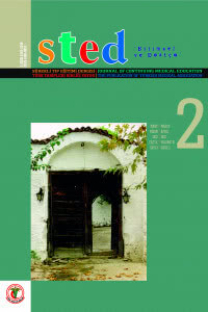Aydın ili 1 nolu AÇSAP merkezi aile planlaması hizmetlerinin değerlendirilmesi
Poliklinikler, Gebelik, istenmeyen, Düşük, istemli, Aile planlama servisleri, Doğum kontrolü, Gebelik önlenmesi, Tıbbi kayıtlar
Evaluating the family planning services: Child health center
Ambulatory Care Facilities, Pregnancy, Unwanted, Abortion, Induced, Family Planning Services, Contraception, Contraception Behavior, Medical Records,
___
- 1-Akın A, Özvarış ŞB. Ana Sağlığı ve Aile Planlaması, içinde: Bertan M, Güler Ç.(Edi) Halk Sağlığı Temel Bilgiler. Ankara: Güneş Kitabevi; 1995. s:133.
- 2-Özvarış ŞB. Aile Planlaması. Sağlık ve Toplum. 1998; 8(3-4): 49-54.
- 3-Güngör L, Açık Y, Güngör YM, Oğuzöncül AF. Elazığ Devlet Hastanesi Aile Planlaması Polikliniğine İsteğe Bağlı Düşük Yapmak için başvuran Kadınlar ve Eşlerinin Aile Planlaması ve İsteğe Bağlı DüşükHakkındaki Bilgi, Tutum, Davranışları. Fırat Tıp Dergisi. 2003; 8(1): 29-33.
- 4-Ana Çocuk Sağlığı ve Aile Planlaması Genel Müdürlüğü'nün Görevleri. TC. Sağlık Bakanlığı. Erişim tarihi: 03.01.2005. http// www.saglikbakanligi.gov.tr.
- 5-Mayda SA, Yakalı G, Murateriman T. Düzce İli Konuralp Kasabasında 15-49 Yaş Evli Kadınların Aile Planlaması Yöntem Kullanma Durumları ve Yöntem Kullanmama Nedenleri. Sağlık ve Toplum. 2004; 14(1): 67-72.
- 6-Türkistanlı Çeber E, Mermer G, Yıldız F. Evka-4 Sağlık Ocağı Bölgesinde 15-49 Yaş Evli Kadınların Kontraseptif Kullanımı ve Bu Durumu Etkileyen Faktörler. Sağlık ve Toplum. 2003; 13(1): 81-86.
- 7-Yıldırım G, Turaçlar N, Bakır A, Özdemir L. Sivas ili Ana-Çocuk Sağlığı Merkezine Başvuran Kadınların Aile Planlaması Yöntem Tercihleri ve Etkileyen Faktörler. Cumhuriyet Üniversitesi Tıp Fakültesi Dergisi. 2003; 25(3): 99-104.
- 8-Kişioğlu AN, Öztürk M, Uşkun E, Kırbıyık S. İsparta İli Sadık Yağcı Ana-Çocuk Sağlığı Aile Planlaması Merkezi'nin Aile Planlaması Polikliniğine 2000 Yılında Başvuran Hastaların Değerlendirilmesi. Sağlık ve Toplum. 2003; 13(1): 68-74.
- 9-Elçioğlu ŞÖ, Ünlüoğlu İ, Özalp S. Aile Planlaması Danışmanlık Hizmetleri ve Kalite. Sağlık ve Toplum. 2000; 3: 3-7
- 10-Türkiye Nüfus ve Sağlık Araştırması 1998. Ankara: Hacettepe Üniversitesi Nüfus Etütleri Enstitüsü; Ekim 1999.
- 11-Akın A. Türkiye'de Ana Sağlığı, Aile Planlaması Hizmetleri ve İsteyerek Düşükler. 1998 Türkiye Nüfus ve Sağlık Araştırması İleri Analiz Sonuçları. 2002. s: 151-182.
- 12-Sağlık 21 Herkese Sağlık Türkiye'nin Hedef ve Stratejileri. Ankara: TC.Sağlık Bakanlığı; Aralık 2001. s: 64
- 13-Aydın Merkezinde İstenmeyen Gebelikler ve Risk Faktörleri. Adnan Menderes Üniversitesi Tıp Fakültesi Halk Sağlığı Anabilim Dalı Uzmanlık Tezi. Aydın, 2004.
- 14-Aytekin NT, İrgil ME, Pala K. Gemlik Bölgesindeki Gebelerin Kullandıkları Aile Planlaması Yöntemlerinin Değerlendirilmesi. Sağlık ve Toplum. 2001 ;11(1): 37-41.
- 15-Polat SA, Açık Y, Gürateş B. Elazığ Devlet Hastanesi Aile Planlaması Polikliniğine Başvuran Kadınların Doğurganlık Özellikleri ve Kullandıkları Aile Planlaması Yöntemleri. Turgut Özal Tıp Merkezi Dergisi. 2000; 7(3): 260-5
- 16-Öztürk M, Kişioğlu AN, Çakmak A. İsparta Gönen'de Kadınların Aile Planlaması Uygulamaları ve Etkileyen Faktörler. Sağlık ve Toplum. 1999; 9(2): 17-21.
- 17-Lüleci E, Nardal İ, Benli M. Manisa Merkezi'nde 15-49 Yaş Arası Evli Kadınların Doğurganlık Davranışları ve Aile Planlaması Uygulamalarının Değerlendirilmesi. 1. Ulusal Ana Çocuk Sağlığı Kongresi, Ankara, 29-31 Mart 2001; Kongre Kitabı:243-4.
- 18-Kazeeroni T, Talci AR., Sadeghi-Hassanabadi A., Arasteh MM., Saalabian J. Reproductive Behavior in Women in Shiraz. East Mediterr Health J 2000; 6(2-3):517-21.
- 19-Diker J, Erkoç A, Karataş N. Dr. İ. Şevki Atasagun Nevşehir Devlet Hastanesinde MR(Menstrüel Regulasyon) Yöntemi ile Gebeliği Sonlandırılan Hastaların Değerlendirilmesi. Sağlık ve Toplum. 2003;13(2): 67-72.
- 20-Akın A. Cultural and Psychosocial Factors Affecting Contraceptive Use and Abortion in Two Provinces of Turkey. Abortion in the Developing World, WHO, 1999. p:195
- 21-Shi-xun G. First Trimester Induced Abortion Behavior Among Married Women in Shangahai, China. Abortion in the Developing World, WHO, 1999. p:78
- 22-Yiğiter Şenol Y, Dönmez L. Antalya Kütükçü 6 No'lu Sağlık Ocağı Bölgesi'nde 15-49 Yaş Evli Kadınlarda İsteyerek Düşük Sıklığı ve Etkileyen Faktörler. Sağlık ve Toplum. 2002;12(4): 62-66.
- 23-Meteoğlu D, Güngör F, Pehlivan A, Doyuran E. 2001 Yılında Aydın İlinde Ana Sağlığı ve Aile Planlaması. Sağlık ve Toplum. 2002;12(1): 33-36.
- 24-Klima SC. Unintended Pregnancy, Consequences and Solutions For A Worldwide Problem. Journal of Nurse-Midwifery, 1998; 43(6): 483-491.
- 25-Çan G, Beşer E, Bozkaya H, Mocan H, Güler Ç. Factors Affecting Unintended Pregnancy Prevalence and The Effects of Those Pregnancies On Health Conditions. Acta Reproductiva Turcica 1994;16(2):127-133.
- 26-Özaydın N, Akın A. İstenmeyen Gebelikler ve Düşüklerin Kadın Sağlığına Etkileri. Sağlık ve Toplum. 1998; 8(3-4): 55-60.
- ISSN: 1300-0853
- Yayın Aralığı: 6
- Başlangıç: 1992
- Yayıncı: -
Cihat ŞANLI, Selda HIZEL, MERYEM ALBAYRAK
15-49 yaş kadınlarda ortalama menarş yaşı
Nurdan TEKGÜL, Dilek SALTIK, Yeşim ŞEN, Sultan KURT
Aydın ili 1 nolu AÇSAP merkezi aile planlaması hizmetlerinin değerlendirilmesi
Ayfer Fırat GEMALMAZ, Pınar OKYAY, Eyüp DOYURAN, Okay BAŞAK, Erdal BEŞER
Travmatik karotid arter diseksiyonu: Olgu sunumu
Şahika Liva CENGİZ, Mehmet Liva CENGİZ
Trafik kaza yaralanmalarında ikincil korunma: Çocuk araba koltukları
Güledal BOZTAŞ, LÜTFİYE HİLAL ÖZCEBE
Gümüşdere Sağlık Ocağı'nda pasif sigara maruziyetinin doğum ağırlığı üzerine etkisi
Yılmaz Sevinç YELTEKİN, Defne KARASİMAV, SIDDİKA SONGÜL YALÇIN
